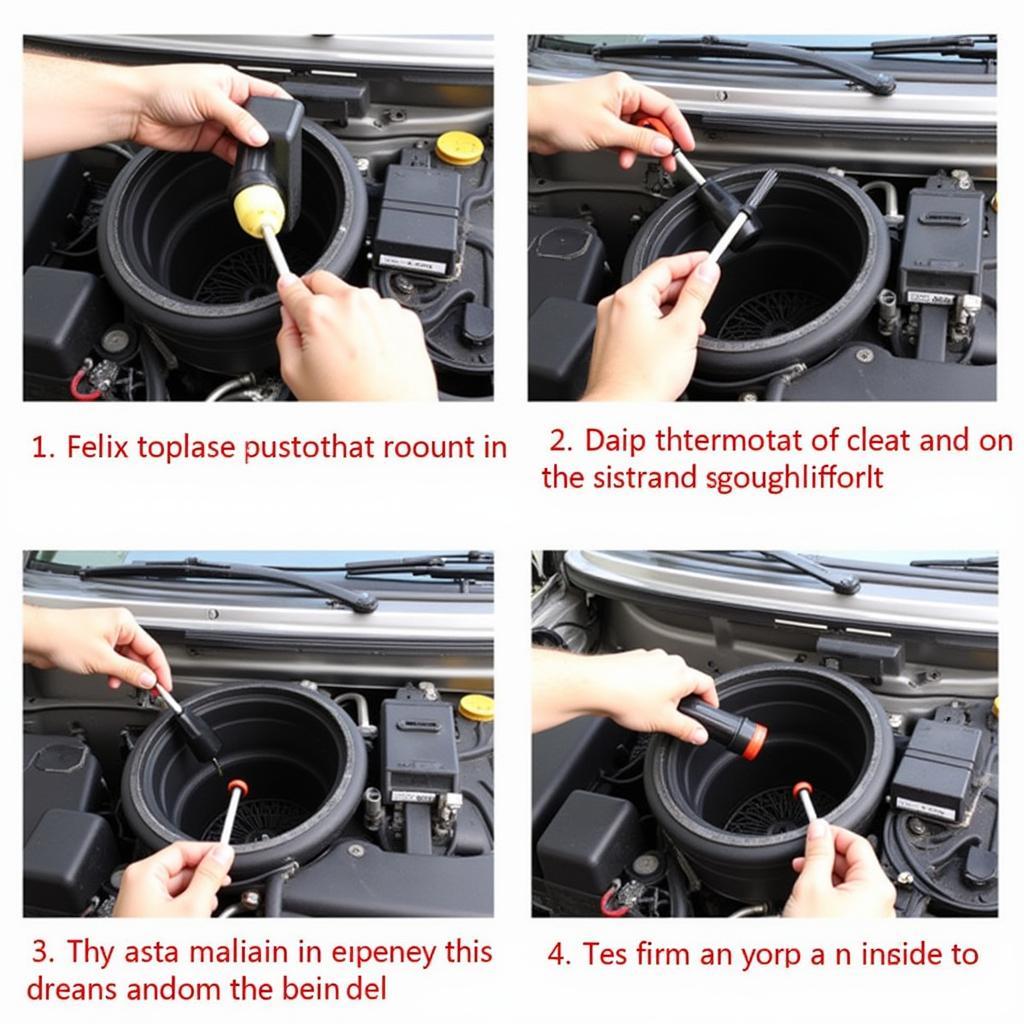A malfunctioning thermostat can lead to overheating, poor fuel economy, and even engine damage. Knowing How To Fix A Broken Thermostat On A Car is an essential skill for any car owner or mechanic. This guide provides a comprehensive walkthrough of the process, helping you diagnose, replace, and troubleshoot thermostat issues.
Understanding the Car Thermostat
The thermostat is a small but vital component of your car’s cooling system. It regulates the flow of coolant to the engine, ensuring it reaches and maintains optimal operating temperature. A stuck-open thermostat can prevent the engine from warming up properly, while a stuck-closed thermostat can cause overheating. Both scenarios can lead to significant problems if left unaddressed.
Diagnosing a Broken Thermostat
Several symptoms indicate a potentially faulty thermostat. If your car is overheating, taking too long to warm up, or showing fluctuating temperature readings, the thermostat could be the culprit. You can also perform a simple test by feeling the upper and lower radiator hoses after the engine has been running for a few minutes. If the upper hose is hot while the lower hose remains cold, it suggests a stuck-closed thermostat.
Gathering Your Tools and Materials
Before starting the repair, gather the necessary tools and materials. You’ll need a new thermostat (make sure it’s the correct one for your car model), coolant, a socket wrench set, screwdrivers, pliers, a drain pan, and safety glasses. Having everything ready will make the process smoother and more efficient. Remember, proper preparation is half the battle.
How to Replace a Car Thermostat: A Step-by-Step Guide
- Locate the Thermostat: The thermostat is typically located near the top of the engine, where the upper radiator hose connects to the engine. Consult your car’s repair manual for the precise location.
- Drain the Coolant: Place a drain pan under the radiator petcock and carefully open it to drain the coolant. Remember to dispose of the old coolant properly.
- Remove the Thermostat Housing: Once the coolant has drained, remove the bolts holding the thermostat housing in place and carefully remove the housing.
- Replace the Thermostat: Remove the old thermostat and install the new one, ensuring it’s oriented correctly. Usually, there’s a jiggle valve or a small air bleed hole that needs to be positioned correctly.
- Reassemble the Housing: Apply a new gasket to the thermostat housing and carefully reinstall it, tightening the bolts to the specified torque.
- Refill the Coolant: Refill the cooling system with the correct type of coolant and bleed the system to remove any air pockets. This involves running the engine with the radiator cap off until the coolant level stabilizes.
- Test the Repair: Run the engine and monitor the temperature gauge to ensure the thermostat is working correctly.
 Replacing a Car Thermostat Step-by-Step
Replacing a Car Thermostat Step-by-Step
Just like [how to fix the heat in my car], replacing a thermostat requires attention to detail.
Troubleshooting Common Issues
If you’ve replaced the thermostat and are still experiencing issues, there could be other problems within the cooling system, such as a faulty water pump, a clogged radiator, or a leak in the system. If you’re unsure about how to proceed, seeking professional help might be necessary. Much like finding someone who fixes car heaters near me, a qualified mechanic can efficiently diagnose and repair these more complex issues.
Finding a solution can be similar to understanding [how do i fix my heater in my car].
Maintaining Your Cooling System
Regular maintenance can prevent thermostat problems and other cooling system issues. Ensure you have the coolant flushed and replaced according to your car’s maintenance schedule. Regularly inspect hoses and belts for wear and tear. By taking these preventative measures, you can keep your car’s cooling system running efficiently and avoid costly repairs down the road. Sometimes knowing [where to fix my car heater] is less important than regular maintenance.
 Car Cooling System Maintenance Tips
Car Cooling System Maintenance Tips
If you need to fix your car’s climate control, you might want to know more about [how to fix climate control in car]. It’s always good to know [who fixes car heaters near me].
Conclusion
Fixing a broken thermostat on a car is a manageable task for many car owners. By following the steps outlined in this guide, you can diagnose, replace, and troubleshoot thermostat issues effectively. However, if you encounter difficulties or are unsure about any part of the process, don’t hesitate to seek professional assistance. A properly functioning cooling system is crucial for your car’s performance and longevity, so addressing any issues promptly is essential. For professional assistance, contact AutoTipPro at +1 (641) 206-8880 or visit our office at 500 N St Mary’s St, San Antonio, TX 78205, United States.
FAQ
- How often should I replace my car’s thermostat? Generally, every 2-3 years or as recommended in your car’s maintenance schedule.
- Can I drive with a broken thermostat? It’s not recommended, as it can lead to engine damage.
- What are the signs of a bad thermostat? Overheating, slow warm-up, fluctuating temperature gauge readings.
- How much does it cost to replace a car thermostat? The cost varies depending on the car model and labor rates.
- What is the function of a car thermostat? It regulates coolant flow to maintain optimal engine temperature.
- Can I replace a car thermostat myself? Yes, with the right tools and some mechanical knowledge.
- What happens if I put the thermostat in backward? The engine could overheat, causing serious damage.





Leave a Reply